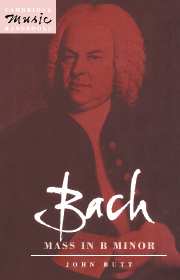Book contents
- Frontmatter
- Contents
- Preface
- List of abbreviations
- 1 The musical genre of the mass Ordinary
- 2 Genesis and purpose
- 3 Reception history
- 4 Text and music: the process of adaptation and composition
- 5 Ritornello forms
- 6 The influence of the dance
- 7 Counterpoint
- 8 Figurae and the motivic texture
- 9 Patterns and proportions: large-scale structuring and continuity in the Mass in B Minor
- Afterword
- Notes
- Select bibliography
- Index
5 - Ritornello forms
Published online by Cambridge University Press: 05 June 2012
- Frontmatter
- Contents
- Preface
- List of abbreviations
- 1 The musical genre of the mass Ordinary
- 2 Genesis and purpose
- 3 Reception history
- 4 Text and music: the process of adaptation and composition
- 5 Ritornello forms
- 6 The influence of the dance
- 7 Counterpoint
- 8 Figurae and the motivic texture
- 9 Patterns and proportions: large-scale structuring and continuity in the Mass in B Minor
- Afterword
- Notes
- Select bibliography
- Index
Summary
Two recent approaches in Bach criticism have emphasised the crucial role of the ritornello principle. First, Robert Marshall's examination of the compositional process in vocal works has shown that most of the compositional activity takes place in the opening ritornellos. Here Bach seemingly searched out the basic inventio of the piece, its principal character and musical material. The composition of the subsequent sections was relatively straightforward, since most musical events were derived directly from ritornello material. Secondly, Laurence Dreyfus's work on Bach's use of ritornello structure in instrumental works has shown how Bach gave great attention to the potential conflicts between established genres and their respective styles, and how much of the music's depth lies in the dislocation of the immediate events from the underlying generative processes.
Traditionally the ritornello has been viewed merely as a structural pillar, introducing and ending the solo/vocal sections and marking important modulations within the movement by reappearing in its entirety or in part. It is with this recurring – and somewhat subservient – function that most commentators of Bach's time were concerned. According to J. G. Walther, ‘Ritornelli are short instrumental repeats not of a complete aria which has been sung or is about to be sung, but (particularly when this is extensive) of only one or several passages out of the same.’
The ‘classical’ ritornello
In 1915 Wilhelm Fischer noted that the ritornello of a Baroque concerto typically falls into three sections: Vordersatz, the introductory gesture, which establishes the tonic key, Fortspinnung, the continuation and extension – usually sequential – of the initial ideas, and Epilog, the formal cadence in the tonic.
- Type
- Chapter
- Information
- Bach: Mass in B Minor , pp. 60 - 69Publisher: Cambridge University PressPrint publication year: 1991



